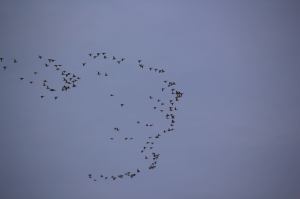A Sustainable Future
Wildfowling has a long history and as wildfowlers we want to continue to go wildfowling in the future. However, we can’t do this if wildfowl populations are depleted or if wetlands are degraded, developed or otherwise lost. Sustainability is often defined along the lines of ‘meeting the needs of the present without compromising the needs of future generations.’
We therefore have to ensure that:
• the numbers of wildfowl we take are well within the capacity of the wildfowl population
• the places we shoot remain in good environmental condition.
If we can achieve these aims then there is no reason why wildfowling should not continue well into the future.
Ensuring the numbers of wildfowl we take are within the capacity of wildfowl populations takes a great deal of effort. Each wildfowler has to make an end-of-year return detailing each wildfowling visit, the locations, times, shots fired and duck taken. These are aggregated at year end and compared with the British Trust for Ornithology (BTO) wildfowl counts. Comparing wildfowl counts with duck taken over many, many years enables us to spot trends and make adjustments. Nationally, wildfowl populations are mostly stable or increasing but locally differences to the national trend can occur. This can result in management measures that encourage members to avoid the more popular sites, to limit the wildfowl they take, or to cease shooting completely in severe weather when birds lose condition. Additionally, periodically we carry out an Appropriate Assessment, which tests the activity of wildfowling against the conservation objectives of the site to ascertain whether there is any impact. For Chichester Harbour this resulted in a 50+page document which compared wildfowling activity with wildfowl trends for a number of species to determine whether wildfowling had any impact.
However, it’s no good wildfowling responsibly if the places we shoot are deteriorating. Habitat management forms a large part of our effort, in fact more hours are spent on conservation activity than on wildfowling. The type of conservation work will depend on the site and can range from tide line litter picks and sea wall maintenance through to reed bed management and water level management. These conservation work parties are great fun and enable members to visibly give something back and see the positive results of their work.
The twin aims of wildfowling responsibly and improving the habitat are complementary and ensure that wildfowling carried out today can be carried out into the future. Indeed, the habitat management enhances biodiversity as it benefits not just wildfowl but other species also.
